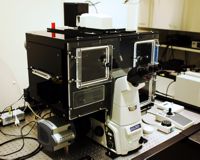|

Contact information _______________________
5th floor office, room B501a 1st floor office, room B117a Biomedicum Helsinki
BIU web site: |
Nikon Eclipse Ti-E N-STORM microscope
Technical Information Microscope Fully motorized Eclipse Ti-E inverted microscope with Nikon IR based Perfect Focus System (PFS) and Nikon motorized XY stage. Software NIS-Elemnrs advanced research ver.4.2 with 6D image aquisition module, JOBS high content module, and STORM analysis. Detectors
Objectives and their properties
Excitation lightsource TIRF/STORM Lasers:
Epifluorescent light:
Accessories for live cell and multiwell imaging Instrument Use
General instructions If you would like to start using Nikon TIRF, please go to our Fees and user policy page for instructions for new users. Important safety issue: avoid looking at the laser light - TIRF lasers are much more powerful than the ones in laser pointers and may be harmful for your eyes. Turn on the lights when you clean up, otherwise you may not notice oil spills and other problems. Cleaning up - instructions what to do after you are done with imaging. In case of an accident - instructions what to do if you spill oil or break glass. All registered TIRF users are automatically added to the TIRF users mailing list. Please read those e-mails to know what's going on! Please contact in advance if you need temperature adjustment for your experiments.
Links
More information on the application and principle of TIRF or STORM can be found from the MicroscopyU introduction to TIRF and STORM.
Page updated 21.10.2016 |
|||||||||||||||||||||||||||||||||||||||||||||||||||||||||||||||||||||||||||||||||||||||||||||||||||

